MBA Assignment 1: Corporate Governance and Dubai SME Analysis
VerifiedAdded on 2020/03/28
|10
|2631
|157
Report
AI Summary
This MBA assignment report examines the significance of corporate governance, particularly within the Small and Medium Enterprises (SMEs) sector of Dubai. The report focuses on the 'Nine Pillars of Good Corporate Governance,' which include establishing a proper framework, succession planning, transparent information flow, a formal Board of Directors (BOD), clear authorization for the BOD, credible financial accounts, internal control structures, recognizing stakeholder needs, and a framework for family-business relationships. The report explores each pillar in detail, emphasizing their importance for SME growth, sustainability, and attracting investment. It highlights the role of stakeholders, the need for transparent financial reporting, the importance of an independent BOD, and the implementation of internal controls. The report also discusses the challenges faced by SMEs in adopting good governance practices and the benefits that can be achieved, such as increased investor confidence and improved financial performance. It concludes by emphasizing the need for SMEs to understand and embrace corporate governance principles to foster growth and navigate the evolving regulatory landscape.

Running head: MBA ASSSIGNMENT
MBA assignment:
Nine Pillars of good corporate governance
Name of Student:
Student ID:
Name of University:
Author’s note:
MBA assignment:
Nine Pillars of good corporate governance
Name of Student:
Student ID:
Name of University:
Author’s note:
Paraphrase This Document
Need a fresh take? Get an instant paraphrase of this document with our AI Paraphraser
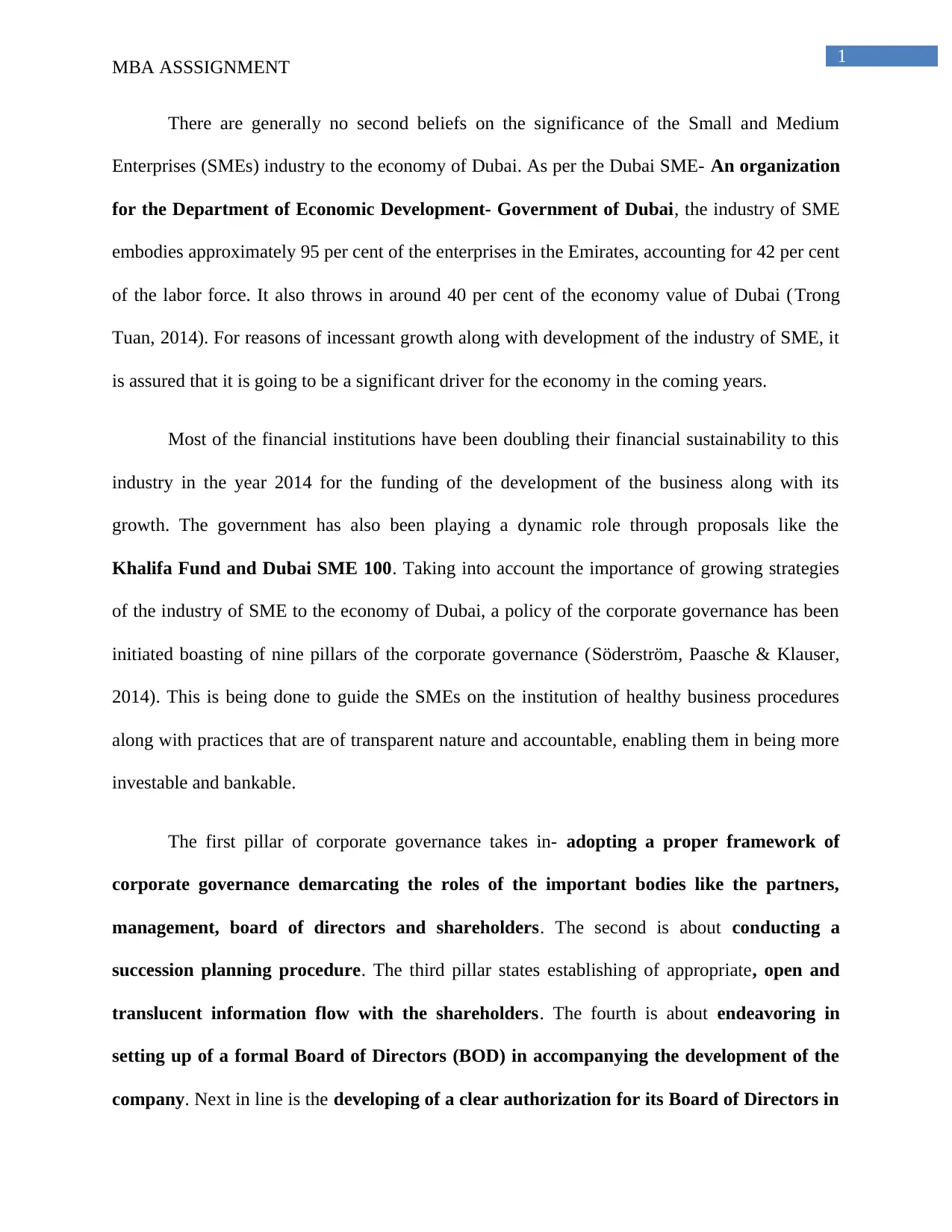
1
MBA ASSSIGNMENT
There are generally no second beliefs on the significance of the Small and Medium
Enterprises (SMEs) industry to the economy of Dubai. As per the Dubai SME- An organization
for the Department of Economic Development- Government of Dubai, the industry of SME
embodies approximately 95 per cent of the enterprises in the Emirates, accounting for 42 per cent
of the labor force. It also throws in around 40 per cent of the economy value of Dubai (Trong
Tuan, 2014). For reasons of incessant growth along with development of the industry of SME, it
is assured that it is going to be a significant driver for the economy in the coming years.
Most of the financial institutions have been doubling their financial sustainability to this
industry in the year 2014 for the funding of the development of the business along with its
growth. The government has also been playing a dynamic role through proposals like the
Khalifa Fund and Dubai SME 100. Taking into account the importance of growing strategies
of the industry of SME to the economy of Dubai, a policy of the corporate governance has been
initiated boasting of nine pillars of the corporate governance (Söderström, Paasche & Klauser,
2014). This is being done to guide the SMEs on the institution of healthy business procedures
along with practices that are of transparent nature and accountable, enabling them in being more
investable and bankable.
The first pillar of corporate governance takes in- adopting a proper framework of
corporate governance demarcating the roles of the important bodies like the partners,
management, board of directors and shareholders. The second is about conducting a
succession planning procedure. The third pillar states establishing of appropriate, open and
translucent information flow with the shareholders. The fourth is about endeavoring in
setting up of a formal Board of Directors (BOD) in accompanying the development of the
company. Next in line is the developing of a clear authorization for its Board of Directors in
MBA ASSSIGNMENT
There are generally no second beliefs on the significance of the Small and Medium
Enterprises (SMEs) industry to the economy of Dubai. As per the Dubai SME- An organization
for the Department of Economic Development- Government of Dubai, the industry of SME
embodies approximately 95 per cent of the enterprises in the Emirates, accounting for 42 per cent
of the labor force. It also throws in around 40 per cent of the economy value of Dubai (Trong
Tuan, 2014). For reasons of incessant growth along with development of the industry of SME, it
is assured that it is going to be a significant driver for the economy in the coming years.
Most of the financial institutions have been doubling their financial sustainability to this
industry in the year 2014 for the funding of the development of the business along with its
growth. The government has also been playing a dynamic role through proposals like the
Khalifa Fund and Dubai SME 100. Taking into account the importance of growing strategies
of the industry of SME to the economy of Dubai, a policy of the corporate governance has been
initiated boasting of nine pillars of the corporate governance (Söderström, Paasche & Klauser,
2014). This is being done to guide the SMEs on the institution of healthy business procedures
along with practices that are of transparent nature and accountable, enabling them in being more
investable and bankable.
The first pillar of corporate governance takes in- adopting a proper framework of
corporate governance demarcating the roles of the important bodies like the partners,
management, board of directors and shareholders. The second is about conducting a
succession planning procedure. The third pillar states establishing of appropriate, open and
translucent information flow with the shareholders. The fourth is about endeavoring in
setting up of a formal Board of Directors (BOD) in accompanying the development of the
company. Next in line is the developing of a clear authorization for its Board of Directors in
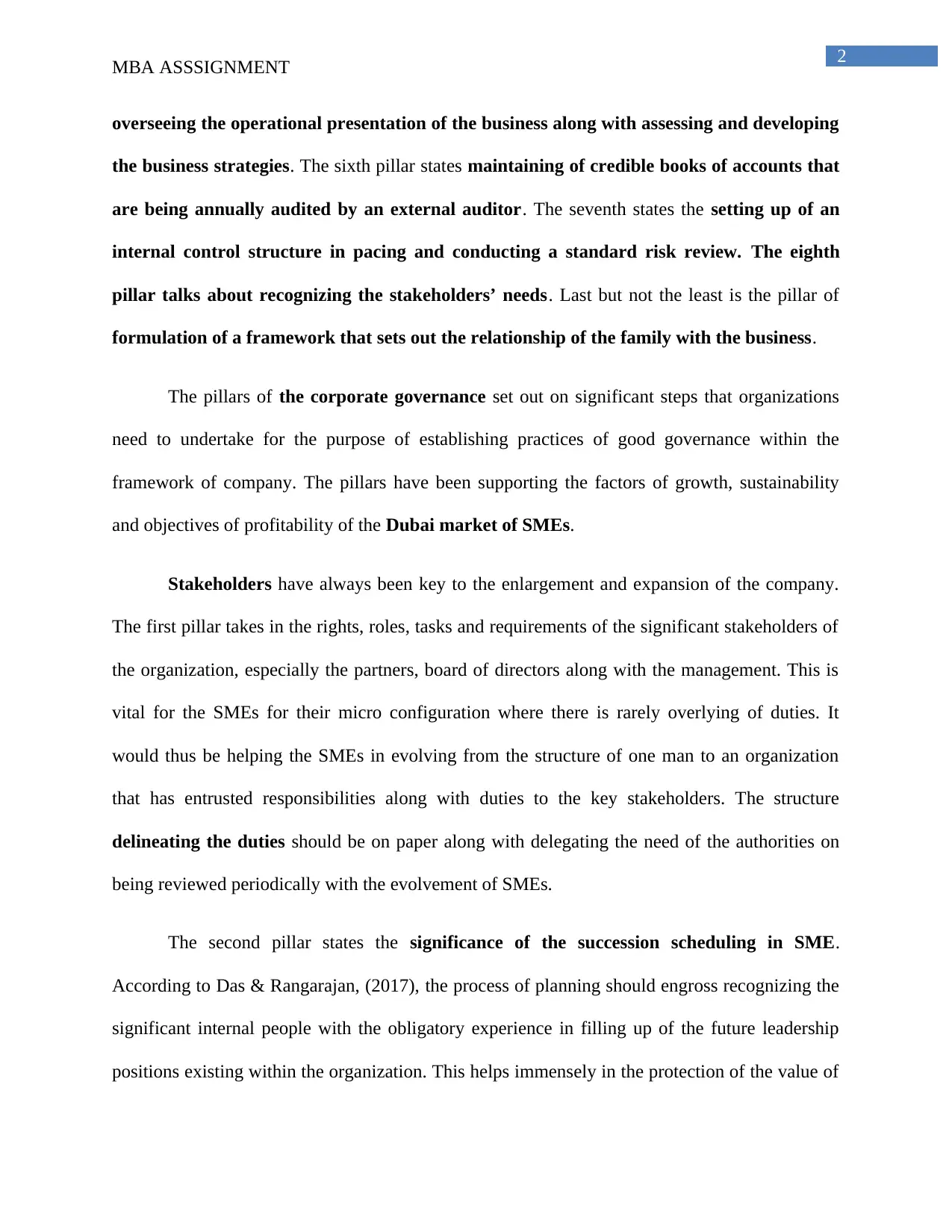
2
MBA ASSSIGNMENT
overseeing the operational presentation of the business along with assessing and developing
the business strategies. The sixth pillar states maintaining of credible books of accounts that
are being annually audited by an external auditor. The seventh states the setting up of an
internal control structure in pacing and conducting a standard risk review. The eighth
pillar talks about recognizing the stakeholders’ needs. Last but not the least is the pillar of
formulation of a framework that sets out the relationship of the family with the business.
The pillars of the corporate governance set out on significant steps that organizations
need to undertake for the purpose of establishing practices of good governance within the
framework of company. The pillars have been supporting the factors of growth, sustainability
and objectives of profitability of the Dubai market of SMEs.
Stakeholders have always been key to the enlargement and expansion of the company.
The first pillar takes in the rights, roles, tasks and requirements of the significant stakeholders of
the organization, especially the partners, board of directors along with the management. This is
vital for the SMEs for their micro configuration where there is rarely overlying of duties. It
would thus be helping the SMEs in evolving from the structure of one man to an organization
that has entrusted responsibilities along with duties to the key stakeholders. The structure
delineating the duties should be on paper along with delegating the need of the authorities on
being reviewed periodically with the evolvement of SMEs.
The second pillar states the significance of the succession scheduling in SME.
According to Das & Rangarajan, (2017), the process of planning should engross recognizing the
significant internal people with the obligatory experience in filling up of the future leadership
positions existing within the organization. This helps immensely in the protection of the value of
MBA ASSSIGNMENT
overseeing the operational presentation of the business along with assessing and developing
the business strategies. The sixth pillar states maintaining of credible books of accounts that
are being annually audited by an external auditor. The seventh states the setting up of an
internal control structure in pacing and conducting a standard risk review. The eighth
pillar talks about recognizing the stakeholders’ needs. Last but not the least is the pillar of
formulation of a framework that sets out the relationship of the family with the business.
The pillars of the corporate governance set out on significant steps that organizations
need to undertake for the purpose of establishing practices of good governance within the
framework of company. The pillars have been supporting the factors of growth, sustainability
and objectives of profitability of the Dubai market of SMEs.
Stakeholders have always been key to the enlargement and expansion of the company.
The first pillar takes in the rights, roles, tasks and requirements of the significant stakeholders of
the organization, especially the partners, board of directors along with the management. This is
vital for the SMEs for their micro configuration where there is rarely overlying of duties. It
would thus be helping the SMEs in evolving from the structure of one man to an organization
that has entrusted responsibilities along with duties to the key stakeholders. The structure
delineating the duties should be on paper along with delegating the need of the authorities on
being reviewed periodically with the evolvement of SMEs.
The second pillar states the significance of the succession scheduling in SME.
According to Das & Rangarajan, (2017), the process of planning should engross recognizing the
significant internal people with the obligatory experience in filling up of the future leadership
positions existing within the organization. This helps immensely in the protection of the value of
⊘ This is a preview!⊘
Do you want full access?
Subscribe today to unlock all pages.

Trusted by 1+ million students worldwide
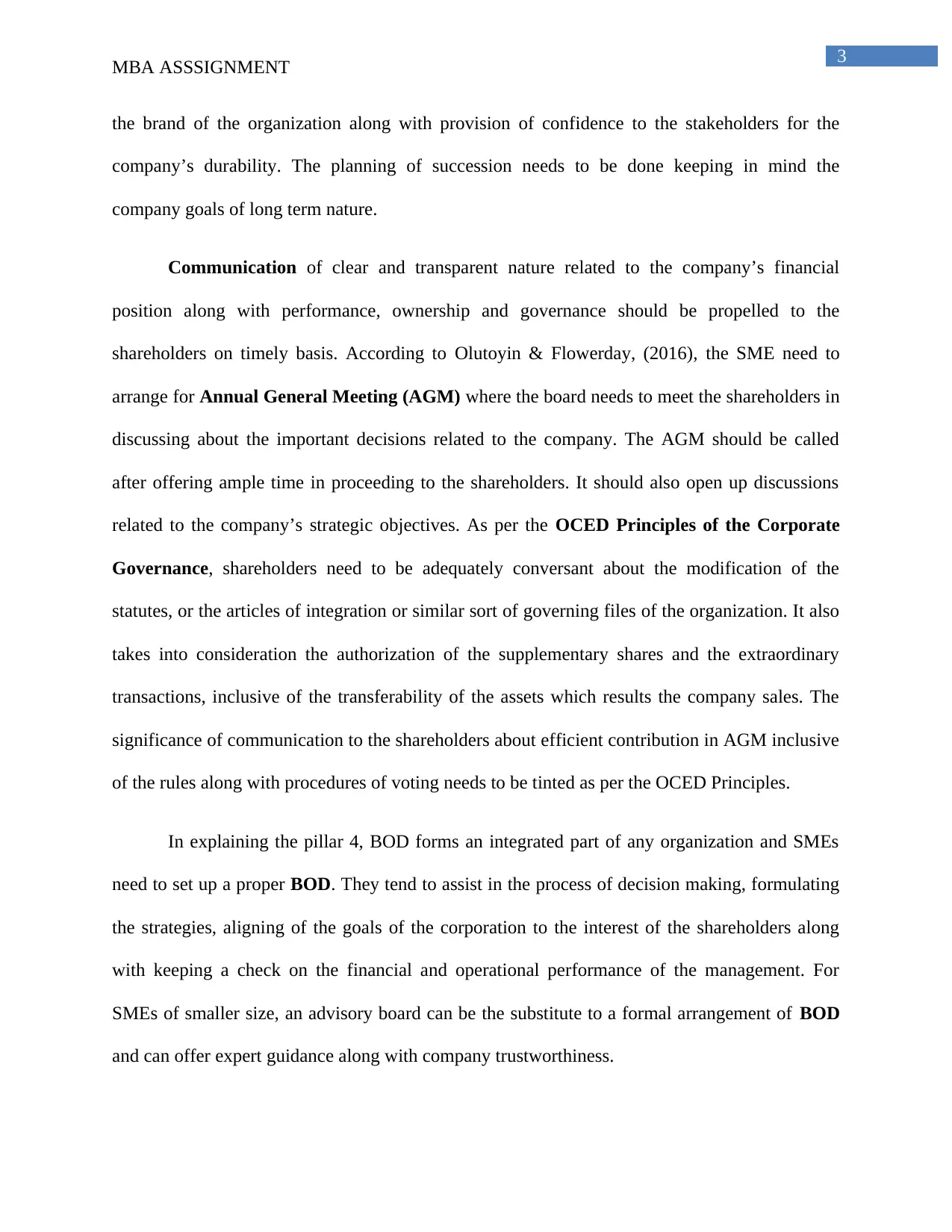
3
MBA ASSSIGNMENT
the brand of the organization along with provision of confidence to the stakeholders for the
company’s durability. The planning of succession needs to be done keeping in mind the
company goals of long term nature.
Communication of clear and transparent nature related to the company’s financial
position along with performance, ownership and governance should be propelled to the
shareholders on timely basis. According to Olutoyin & Flowerday, (2016), the SME need to
arrange for Annual General Meeting (AGM) where the board needs to meet the shareholders in
discussing about the important decisions related to the company. The AGM should be called
after offering ample time in proceeding to the shareholders. It should also open up discussions
related to the company’s strategic objectives. As per the OCED Principles of the Corporate
Governance, shareholders need to be adequately conversant about the modification of the
statutes, or the articles of integration or similar sort of governing files of the organization. It also
takes into consideration the authorization of the supplementary shares and the extraordinary
transactions, inclusive of the transferability of the assets which results the company sales. The
significance of communication to the shareholders about efficient contribution in AGM inclusive
of the rules along with procedures of voting needs to be tinted as per the OCED Principles.
In explaining the pillar 4, BOD forms an integrated part of any organization and SMEs
need to set up a proper BOD. They tend to assist in the process of decision making, formulating
the strategies, aligning of the goals of the corporation to the interest of the shareholders along
with keeping a check on the financial and operational performance of the management. For
SMEs of smaller size, an advisory board can be the substitute to a formal arrangement of BOD
and can offer expert guidance along with company trustworthiness.
MBA ASSSIGNMENT
the brand of the organization along with provision of confidence to the stakeholders for the
company’s durability. The planning of succession needs to be done keeping in mind the
company goals of long term nature.
Communication of clear and transparent nature related to the company’s financial
position along with performance, ownership and governance should be propelled to the
shareholders on timely basis. According to Olutoyin & Flowerday, (2016), the SME need to
arrange for Annual General Meeting (AGM) where the board needs to meet the shareholders in
discussing about the important decisions related to the company. The AGM should be called
after offering ample time in proceeding to the shareholders. It should also open up discussions
related to the company’s strategic objectives. As per the OCED Principles of the Corporate
Governance, shareholders need to be adequately conversant about the modification of the
statutes, or the articles of integration or similar sort of governing files of the organization. It also
takes into consideration the authorization of the supplementary shares and the extraordinary
transactions, inclusive of the transferability of the assets which results the company sales. The
significance of communication to the shareholders about efficient contribution in AGM inclusive
of the rules along with procedures of voting needs to be tinted as per the OCED Principles.
In explaining the pillar 4, BOD forms an integrated part of any organization and SMEs
need to set up a proper BOD. They tend to assist in the process of decision making, formulating
the strategies, aligning of the goals of the corporation to the interest of the shareholders along
with keeping a check on the financial and operational performance of the management. For
SMEs of smaller size, an advisory board can be the substitute to a formal arrangement of BOD
and can offer expert guidance along with company trustworthiness.
Paraphrase This Document
Need a fresh take? Get an instant paraphrase of this document with our AI Paraphraser
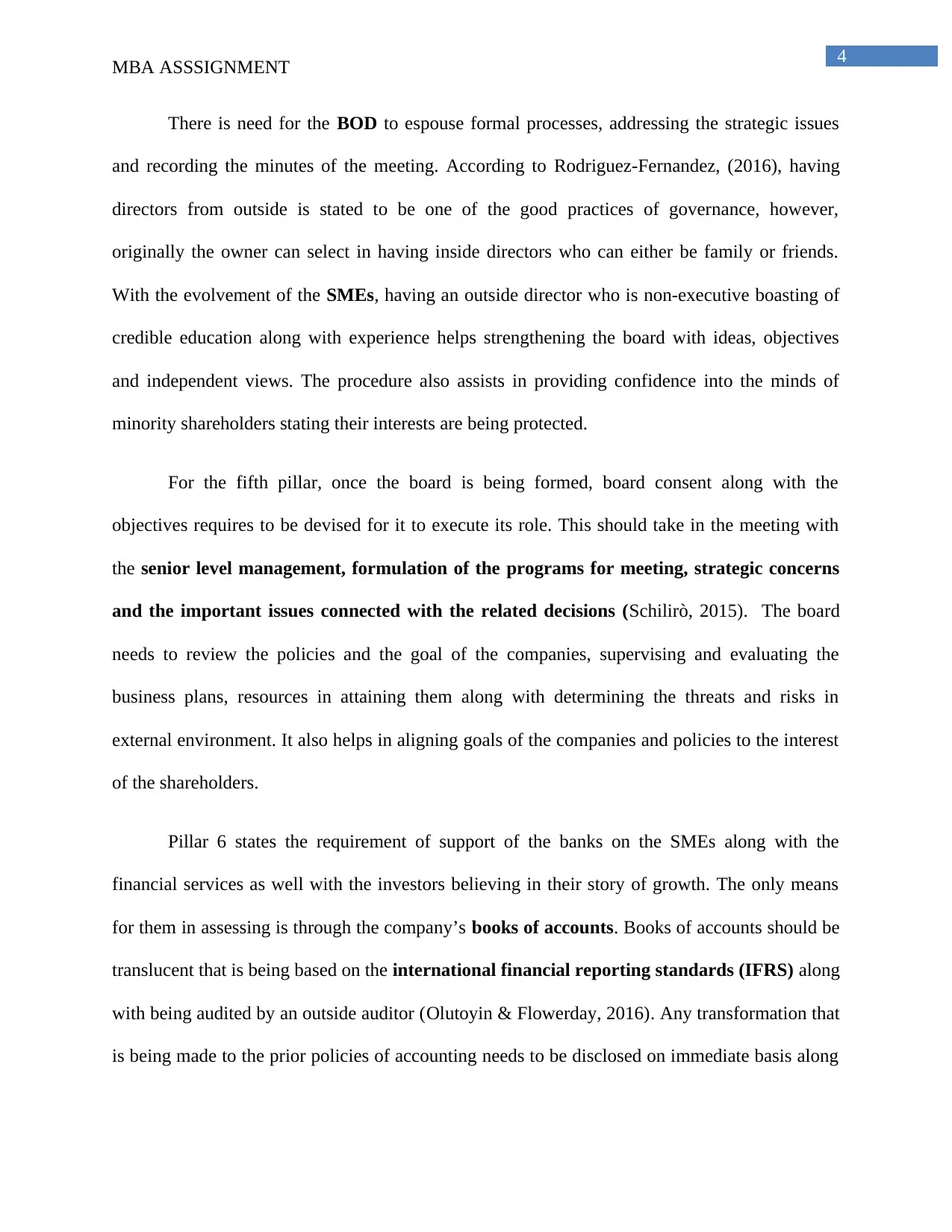
4
MBA ASSSIGNMENT
There is need for the BOD to espouse formal processes, addressing the strategic issues
and recording the minutes of the meeting. According to Rodriguez-Fernandez, (2016), having
directors from outside is stated to be one of the good practices of governance, however,
originally the owner can select in having inside directors who can either be family or friends.
With the evolvement of the SMEs, having an outside director who is non-executive boasting of
credible education along with experience helps strengthening the board with ideas, objectives
and independent views. The procedure also assists in providing confidence into the minds of
minority shareholders stating their interests are being protected.
For the fifth pillar, once the board is being formed, board consent along with the
objectives requires to be devised for it to execute its role. This should take in the meeting with
the senior level management, formulation of the programs for meeting, strategic concerns
and the important issues connected with the related decisions (Schilirò, 2015). The board
needs to review the policies and the goal of the companies, supervising and evaluating the
business plans, resources in attaining them along with determining the threats and risks in
external environment. It also helps in aligning goals of the companies and policies to the interest
of the shareholders.
Pillar 6 states the requirement of support of the banks on the SMEs along with the
financial services as well with the investors believing in their story of growth. The only means
for them in assessing is through the company’s books of accounts. Books of accounts should be
translucent that is being based on the international financial reporting standards (IFRS) along
with being audited by an outside auditor (Olutoyin & Flowerday, 2016). Any transformation that
is being made to the prior policies of accounting needs to be disclosed on immediate basis along
MBA ASSSIGNMENT
There is need for the BOD to espouse formal processes, addressing the strategic issues
and recording the minutes of the meeting. According to Rodriguez-Fernandez, (2016), having
directors from outside is stated to be one of the good practices of governance, however,
originally the owner can select in having inside directors who can either be family or friends.
With the evolvement of the SMEs, having an outside director who is non-executive boasting of
credible education along with experience helps strengthening the board with ideas, objectives
and independent views. The procedure also assists in providing confidence into the minds of
minority shareholders stating their interests are being protected.
For the fifth pillar, once the board is being formed, board consent along with the
objectives requires to be devised for it to execute its role. This should take in the meeting with
the senior level management, formulation of the programs for meeting, strategic concerns
and the important issues connected with the related decisions (Schilirò, 2015). The board
needs to review the policies and the goal of the companies, supervising and evaluating the
business plans, resources in attaining them along with determining the threats and risks in
external environment. It also helps in aligning goals of the companies and policies to the interest
of the shareholders.
Pillar 6 states the requirement of support of the banks on the SMEs along with the
financial services as well with the investors believing in their story of growth. The only means
for them in assessing is through the company’s books of accounts. Books of accounts should be
translucent that is being based on the international financial reporting standards (IFRS) along
with being audited by an outside auditor (Olutoyin & Flowerday, 2016). Any transformation that
is being made to the prior policies of accounting needs to be disclosed on immediate basis along
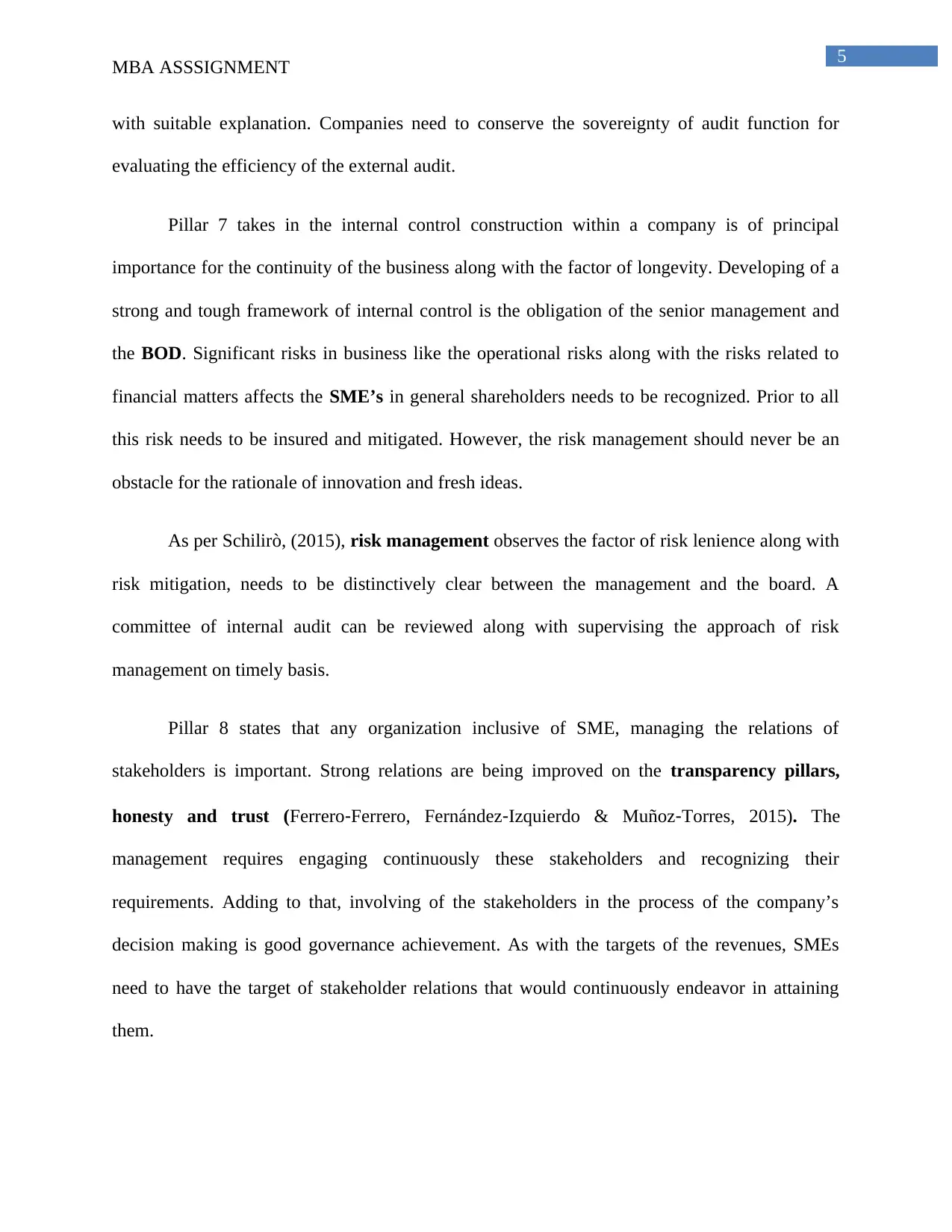
5
MBA ASSSIGNMENT
with suitable explanation. Companies need to conserve the sovereignty of audit function for
evaluating the efficiency of the external audit.
Pillar 7 takes in the internal control construction within a company is of principal
importance for the continuity of the business along with the factor of longevity. Developing of a
strong and tough framework of internal control is the obligation of the senior management and
the BOD. Significant risks in business like the operational risks along with the risks related to
financial matters affects the SME’s in general shareholders needs to be recognized. Prior to all
this risk needs to be insured and mitigated. However, the risk management should never be an
obstacle for the rationale of innovation and fresh ideas.
As per Schilirò, (2015), risk management observes the factor of risk lenience along with
risk mitigation, needs to be distinctively clear between the management and the board. A
committee of internal audit can be reviewed along with supervising the approach of risk
management on timely basis.
Pillar 8 states that any organization inclusive of SME, managing the relations of
stakeholders is important. Strong relations are being improved on the transparency pillars,
honesty and trust (Ferrero‐Ferrero, Fernández‐Izquierdo & Muñoz‐Torres, 2015). The
management requires engaging continuously these stakeholders and recognizing their
requirements. Adding to that, involving of the stakeholders in the process of the company’s
decision making is good governance achievement. As with the targets of the revenues, SMEs
need to have the target of stakeholder relations that would continuously endeavor in attaining
them.
MBA ASSSIGNMENT
with suitable explanation. Companies need to conserve the sovereignty of audit function for
evaluating the efficiency of the external audit.
Pillar 7 takes in the internal control construction within a company is of principal
importance for the continuity of the business along with the factor of longevity. Developing of a
strong and tough framework of internal control is the obligation of the senior management and
the BOD. Significant risks in business like the operational risks along with the risks related to
financial matters affects the SME’s in general shareholders needs to be recognized. Prior to all
this risk needs to be insured and mitigated. However, the risk management should never be an
obstacle for the rationale of innovation and fresh ideas.
As per Schilirò, (2015), risk management observes the factor of risk lenience along with
risk mitigation, needs to be distinctively clear between the management and the board. A
committee of internal audit can be reviewed along with supervising the approach of risk
management on timely basis.
Pillar 8 states that any organization inclusive of SME, managing the relations of
stakeholders is important. Strong relations are being improved on the transparency pillars,
honesty and trust (Ferrero‐Ferrero, Fernández‐Izquierdo & Muñoz‐Torres, 2015). The
management requires engaging continuously these stakeholders and recognizing their
requirements. Adding to that, involving of the stakeholders in the process of the company’s
decision making is good governance achievement. As with the targets of the revenues, SMEs
need to have the target of stakeholder relations that would continuously endeavor in attaining
them.
⊘ This is a preview!⊘
Do you want full access?
Subscribe today to unlock all pages.

Trusted by 1+ million students worldwide
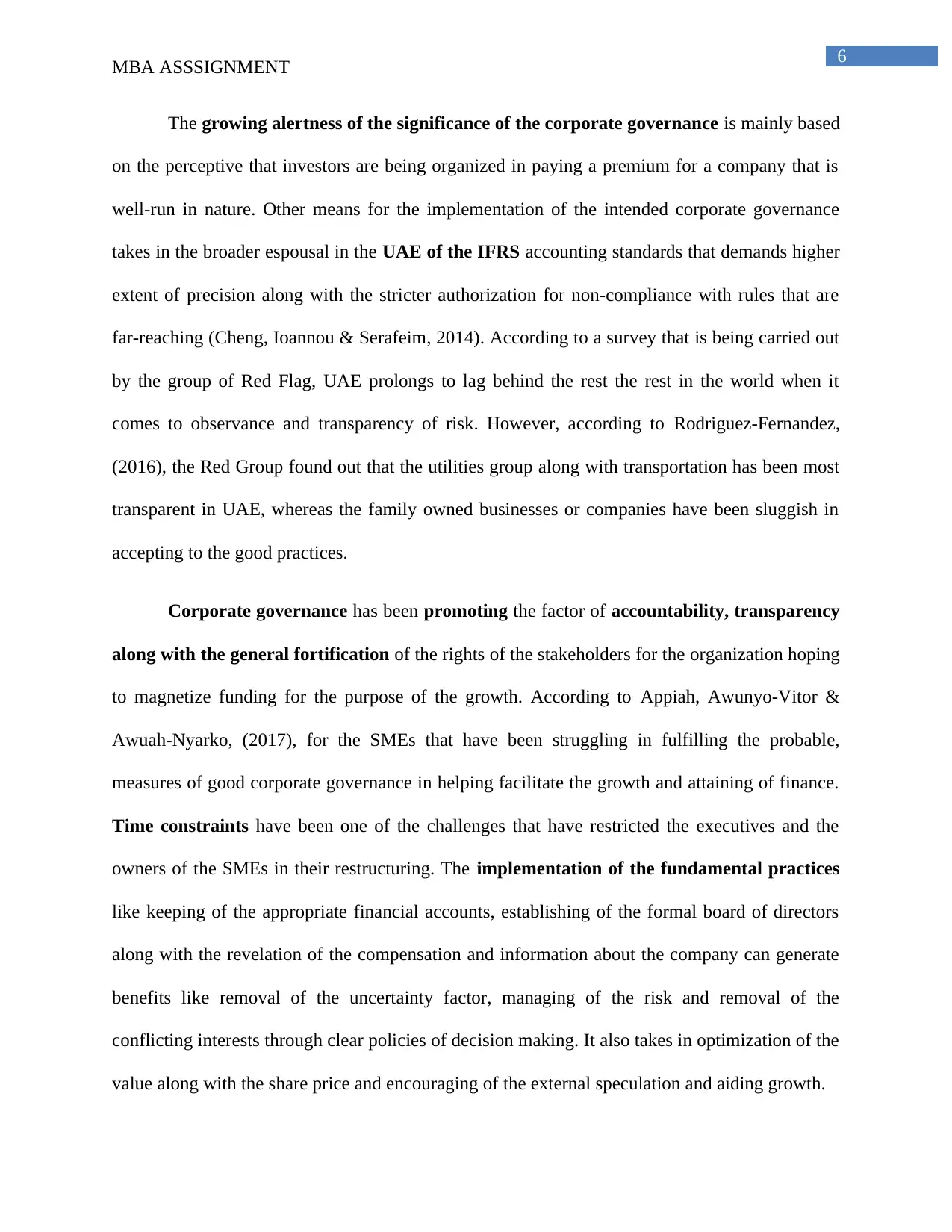
6
MBA ASSSIGNMENT
The growing alertness of the significance of the corporate governance is mainly based
on the perceptive that investors are being organized in paying a premium for a company that is
well-run in nature. Other means for the implementation of the intended corporate governance
takes in the broader espousal in the UAE of the IFRS accounting standards that demands higher
extent of precision along with the stricter authorization for non-compliance with rules that are
far-reaching (Cheng, Ioannou & Serafeim, 2014). According to a survey that is being carried out
by the group of Red Flag, UAE prolongs to lag behind the rest the rest in the world when it
comes to observance and transparency of risk. However, according to Rodriguez-Fernandez,
(2016), the Red Group found out that the utilities group along with transportation has been most
transparent in UAE, whereas the family owned businesses or companies have been sluggish in
accepting to the good practices.
Corporate governance has been promoting the factor of accountability, transparency
along with the general fortification of the rights of the stakeholders for the organization hoping
to magnetize funding for the purpose of the growth. According to Appiah, Awunyo-Vitor &
Awuah-Nyarko, (2017), for the SMEs that have been struggling in fulfilling the probable,
measures of good corporate governance in helping facilitate the growth and attaining of finance.
Time constraints have been one of the challenges that have restricted the executives and the
owners of the SMEs in their restructuring. The implementation of the fundamental practices
like keeping of the appropriate financial accounts, establishing of the formal board of directors
along with the revelation of the compensation and information about the company can generate
benefits like removal of the uncertainty factor, managing of the risk and removal of the
conflicting interests through clear policies of decision making. It also takes in optimization of the
value along with the share price and encouraging of the external speculation and aiding growth.
MBA ASSSIGNMENT
The growing alertness of the significance of the corporate governance is mainly based
on the perceptive that investors are being organized in paying a premium for a company that is
well-run in nature. Other means for the implementation of the intended corporate governance
takes in the broader espousal in the UAE of the IFRS accounting standards that demands higher
extent of precision along with the stricter authorization for non-compliance with rules that are
far-reaching (Cheng, Ioannou & Serafeim, 2014). According to a survey that is being carried out
by the group of Red Flag, UAE prolongs to lag behind the rest the rest in the world when it
comes to observance and transparency of risk. However, according to Rodriguez-Fernandez,
(2016), the Red Group found out that the utilities group along with transportation has been most
transparent in UAE, whereas the family owned businesses or companies have been sluggish in
accepting to the good practices.
Corporate governance has been promoting the factor of accountability, transparency
along with the general fortification of the rights of the stakeholders for the organization hoping
to magnetize funding for the purpose of the growth. According to Appiah, Awunyo-Vitor &
Awuah-Nyarko, (2017), for the SMEs that have been struggling in fulfilling the probable,
measures of good corporate governance in helping facilitate the growth and attaining of finance.
Time constraints have been one of the challenges that have restricted the executives and the
owners of the SMEs in their restructuring. The implementation of the fundamental practices
like keeping of the appropriate financial accounts, establishing of the formal board of directors
along with the revelation of the compensation and information about the company can generate
benefits like removal of the uncertainty factor, managing of the risk and removal of the
conflicting interests through clear policies of decision making. It also takes in optimization of the
value along with the share price and encouraging of the external speculation and aiding growth.
Paraphrase This Document
Need a fresh take? Get an instant paraphrase of this document with our AI Paraphraser
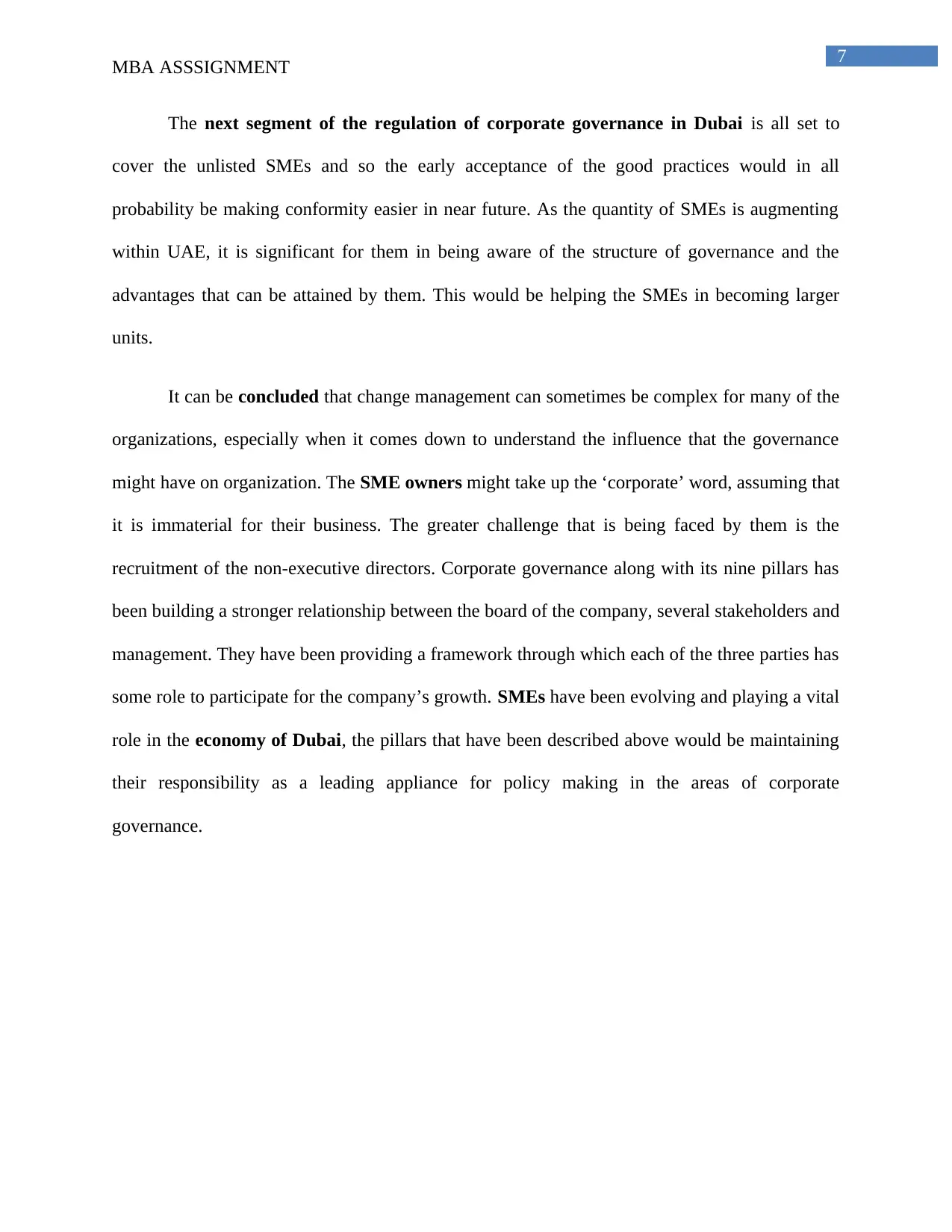
7
MBA ASSSIGNMENT
The next segment of the regulation of corporate governance in Dubai is all set to
cover the unlisted SMEs and so the early acceptance of the good practices would in all
probability be making conformity easier in near future. As the quantity of SMEs is augmenting
within UAE, it is significant for them in being aware of the structure of governance and the
advantages that can be attained by them. This would be helping the SMEs in becoming larger
units.
It can be concluded that change management can sometimes be complex for many of the
organizations, especially when it comes down to understand the influence that the governance
might have on organization. The SME owners might take up the ‘corporate’ word, assuming that
it is immaterial for their business. The greater challenge that is being faced by them is the
recruitment of the non-executive directors. Corporate governance along with its nine pillars has
been building a stronger relationship between the board of the company, several stakeholders and
management. They have been providing a framework through which each of the three parties has
some role to participate for the company’s growth. SMEs have been evolving and playing a vital
role in the economy of Dubai, the pillars that have been described above would be maintaining
their responsibility as a leading appliance for policy making in the areas of corporate
governance.
MBA ASSSIGNMENT
The next segment of the regulation of corporate governance in Dubai is all set to
cover the unlisted SMEs and so the early acceptance of the good practices would in all
probability be making conformity easier in near future. As the quantity of SMEs is augmenting
within UAE, it is significant for them in being aware of the structure of governance and the
advantages that can be attained by them. This would be helping the SMEs in becoming larger
units.
It can be concluded that change management can sometimes be complex for many of the
organizations, especially when it comes down to understand the influence that the governance
might have on organization. The SME owners might take up the ‘corporate’ word, assuming that
it is immaterial for their business. The greater challenge that is being faced by them is the
recruitment of the non-executive directors. Corporate governance along with its nine pillars has
been building a stronger relationship between the board of the company, several stakeholders and
management. They have been providing a framework through which each of the three parties has
some role to participate for the company’s growth. SMEs have been evolving and playing a vital
role in the economy of Dubai, the pillars that have been described above would be maintaining
their responsibility as a leading appliance for policy making in the areas of corporate
governance.
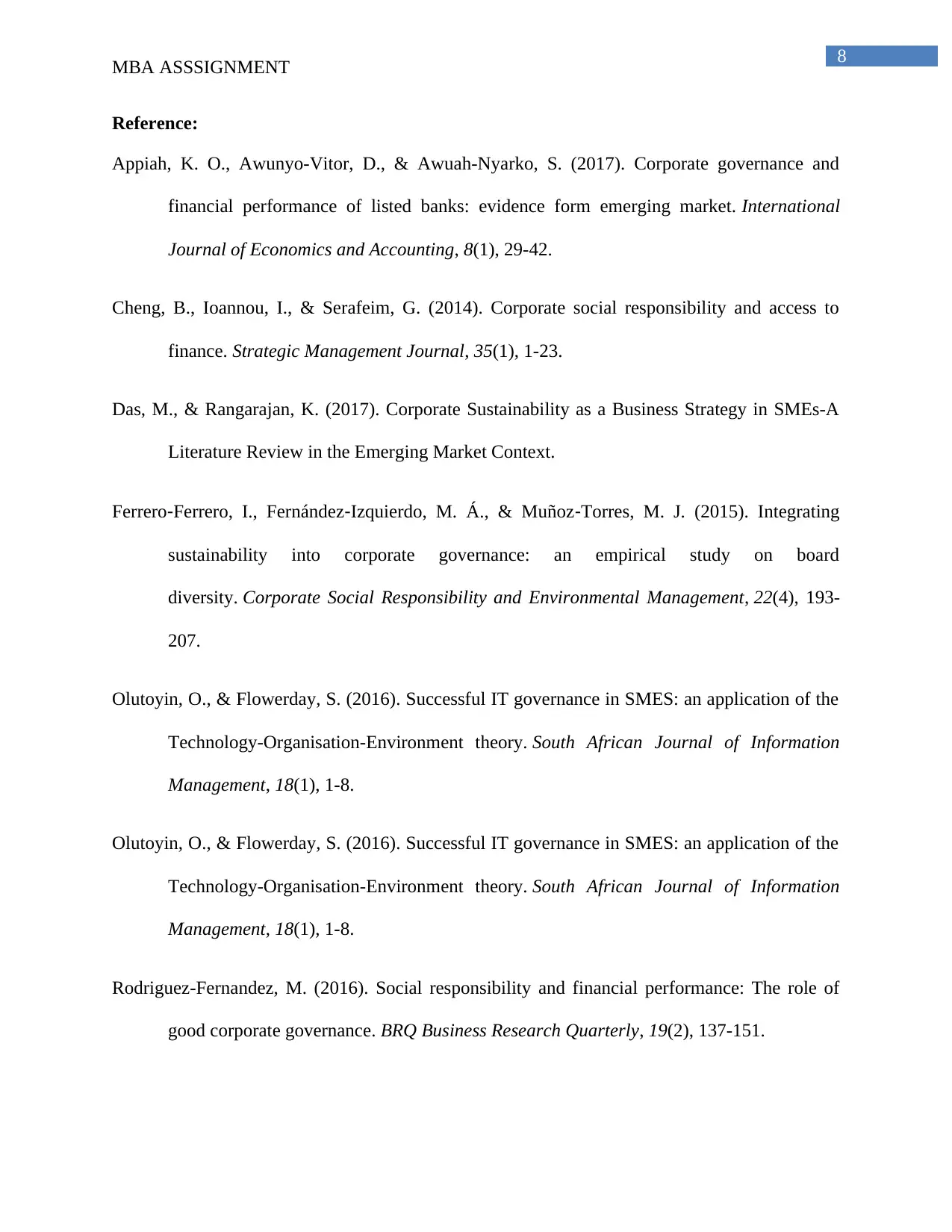
8
MBA ASSSIGNMENT
Reference:
Appiah, K. O., Awunyo-Vitor, D., & Awuah-Nyarko, S. (2017). Corporate governance and
financial performance of listed banks: evidence form emerging market. International
Journal of Economics and Accounting, 8(1), 29-42.
Cheng, B., Ioannou, I., & Serafeim, G. (2014). Corporate social responsibility and access to
finance. Strategic Management Journal, 35(1), 1-23.
Das, M., & Rangarajan, K. (2017). Corporate Sustainability as a Business Strategy in SMEs-A
Literature Review in the Emerging Market Context.
Ferrero‐Ferrero, I., Fernández‐Izquierdo, M. Á., & Muñoz‐Torres, M. J. (2015). Integrating
sustainability into corporate governance: an empirical study on board
diversity. Corporate Social Responsibility and Environmental Management, 22(4), 193-
207.
Olutoyin, O., & Flowerday, S. (2016). Successful IT governance in SMES: an application of the
Technology-Organisation-Environment theory. South African Journal of Information
Management, 18(1), 1-8.
Olutoyin, O., & Flowerday, S. (2016). Successful IT governance in SMES: an application of the
Technology-Organisation-Environment theory. South African Journal of Information
Management, 18(1), 1-8.
Rodriguez-Fernandez, M. (2016). Social responsibility and financial performance: The role of
good corporate governance. BRQ Business Research Quarterly, 19(2), 137-151.
MBA ASSSIGNMENT
Reference:
Appiah, K. O., Awunyo-Vitor, D., & Awuah-Nyarko, S. (2017). Corporate governance and
financial performance of listed banks: evidence form emerging market. International
Journal of Economics and Accounting, 8(1), 29-42.
Cheng, B., Ioannou, I., & Serafeim, G. (2014). Corporate social responsibility and access to
finance. Strategic Management Journal, 35(1), 1-23.
Das, M., & Rangarajan, K. (2017). Corporate Sustainability as a Business Strategy in SMEs-A
Literature Review in the Emerging Market Context.
Ferrero‐Ferrero, I., Fernández‐Izquierdo, M. Á., & Muñoz‐Torres, M. J. (2015). Integrating
sustainability into corporate governance: an empirical study on board
diversity. Corporate Social Responsibility and Environmental Management, 22(4), 193-
207.
Olutoyin, O., & Flowerday, S. (2016). Successful IT governance in SMES: an application of the
Technology-Organisation-Environment theory. South African Journal of Information
Management, 18(1), 1-8.
Olutoyin, O., & Flowerday, S. (2016). Successful IT governance in SMES: an application of the
Technology-Organisation-Environment theory. South African Journal of Information
Management, 18(1), 1-8.
Rodriguez-Fernandez, M. (2016). Social responsibility and financial performance: The role of
good corporate governance. BRQ Business Research Quarterly, 19(2), 137-151.
⊘ This is a preview!⊘
Do you want full access?
Subscribe today to unlock all pages.

Trusted by 1+ million students worldwide
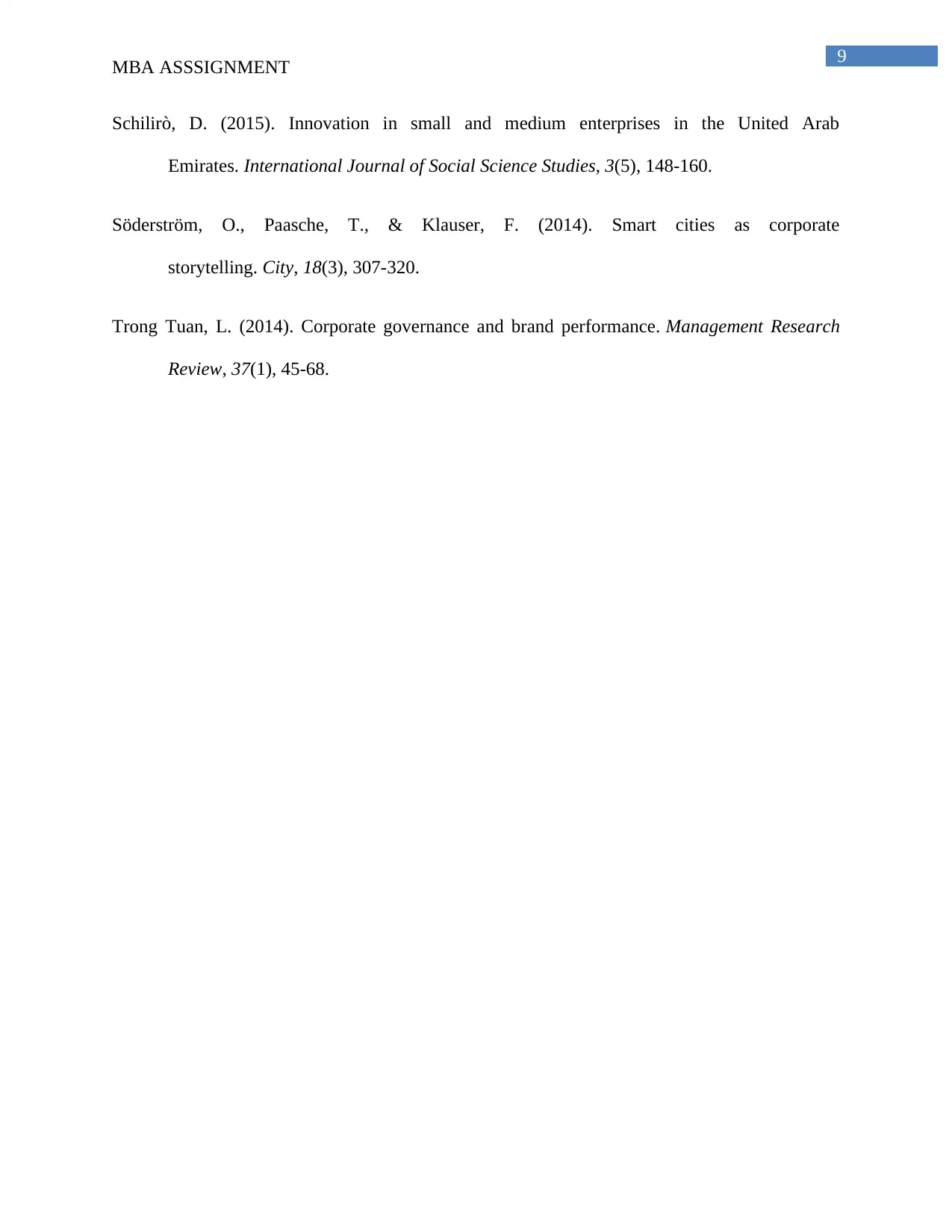
9
MBA ASSSIGNMENT
Schilirò, D. (2015). Innovation in small and medium enterprises in the United Arab
Emirates. International Journal of Social Science Studies, 3(5), 148-160.
Söderström, O., Paasche, T., & Klauser, F. (2014). Smart cities as corporate
storytelling. City, 18(3), 307-320.
Trong Tuan, L. (2014). Corporate governance and brand performance. Management Research
Review, 37(1), 45-68.
MBA ASSSIGNMENT
Schilirò, D. (2015). Innovation in small and medium enterprises in the United Arab
Emirates. International Journal of Social Science Studies, 3(5), 148-160.
Söderström, O., Paasche, T., & Klauser, F. (2014). Smart cities as corporate
storytelling. City, 18(3), 307-320.
Trong Tuan, L. (2014). Corporate governance and brand performance. Management Research
Review, 37(1), 45-68.
1 out of 10
Related Documents
Your All-in-One AI-Powered Toolkit for Academic Success.
+13062052269
info@desklib.com
Available 24*7 on WhatsApp / Email
![[object Object]](/_next/static/media/star-bottom.7253800d.svg)
Unlock your academic potential
Copyright © 2020–2025 A2Z Services. All Rights Reserved. Developed and managed by ZUCOL.





